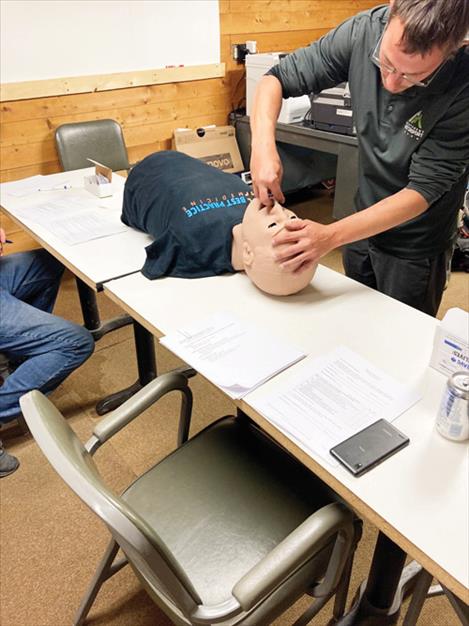New St. Ignatius police chief outlines plans for future
Hey savvy news reader! Thanks for choosing local.
You are now reading
1 of 3 free articles.
ST. IGNATIUS — Chief of Police Jason Acheson was sworn in on July 7, and since then has been working to implement new measures in the police force.
Originally from Columbia Falls, Acheson has worked throughout the Flathead in his career. He started out as a reserve police officer in Columbia Falls in 2000, becoming a fulltime officer close to the 9/11 terrorist attack. From there, he became an officer in Whitefish in 2007 until late 2013 when he took a break of service.
In 2015 he went to work in Ronan, before moving to Florida for three years where he worked as a corrections officer. Missing Montana and law enforcement, he made his move back right around the strike of Covid-19 in 2020.
While he was reestablishing himself, Acheson worked part time in Polson and Hot Springs, where he also received training to become a certified EMT. Even after applying for and receiving the Chief of Police position in St. Ignatius earlier this year, he still occasionally works on an ambulance.
Thanks to delving into the medical field, Acheson said, led him to other things medically related, including Narcan training.
Narcan, also known as Naloxone, is a medication that can quickly reverse the effects of overdoses from opioids such as oxycodone, heroin, and fentanyl.
“When I was over in Hot Springs, we already knew fentanyl was in the area… I wanted to get Narcan in the area, because rural communities I found out were really struggling with getting it,” Acheson explained. While larger municipalities like Missoula and Kalispell can get Narcan to the public at no cost, rural areas don’t have those kinds of grants available. That’s where the Narcan training comes in.
“This is something that’s sanctioned by the State of Montana through the department of health and human services, through a grant, so people who attend this Narcan training, for two years they get free Narcan to keep with them in case they should ever need it,” Acheson said. “If people feel like they need to carry it for their own protection, or out of concern for someone else or a loved one… or even children in the household exposed to that kind of environment and inadvertently ingesting or consuming a narcotic, and that Narcan can save their life.”
A Narcan Master Trainer outside of his police and EMT duties, Acheson is working to get more master trainers brought in to offer more training to the general public. Right now Acheson is offering one training per month until he can get more help, and the next session will be in Thompson Falls in October. Future trainings will be announced on the new St. Ignatius Facebook page at https://www.facebook.com/St-Ignatius-Police-Department-Lake-County-Montana-101939175927439/ as well as advertised locally. Those interested in participating can call the office at 406-745-3881 or email Acheson at chief@townofstignatius.com.
“It’s one service I want to bring to the community, and it’s very, very needed,” Acheson said.
Additional improvements Acheson is working to bring to the police department include obtaining important equipment for health and safety.
Recently, Acheson was able to obtain $2,000 from the Mason Moore Foundation to purchase body armor, as Acheson had been going without a vest and another officer’s vest was close to expiring. The organization was founded by the widow of Broadwater County Deputy Sheriff Mason Moore who was gunned down in the line of duty in 2017. Although the foundation hadn’t been accepting grants at the time, when Acheson reached out to explain their need, the foundation gave the department twice the amount they asked for. Acheson credits them for incredible support for the police force in Montana.
Acheson also got in touch with the State of Montana to acquire AED defibrillators for patrol cars, as he said their officers are often first on scene to a lot of medical calls. “Those also kind of tie into Narcan,” he added. “When you’re administering Narcan, chances are you’re going to have to do CPR, and when you’re doing CPR you almost always need an AED if you can get one. They’re critical for any sort of cardiac.”
Additionally, Acheson is working to update the department’s policy and procedure around his other duties to, in the future, hire reserve officers for extra help in critical instances.
“I feel like a lot of people still don’t know there’s been a change in leadership here, so… I’m just trying to make sure for the people I haven’t been able to get out and meet, or the folks that don’t know, I just want them to know the force has a new chief in the office and with that there’ll be some positive changes,” Acheson said. “I want to work more with the community, I want to have more transparency with the community, and I want to create, build, and maintain trust that may or may not have been there before... We can always do better.”
The changes will take a while to implement, Acheson stressed, as the small department has a lot on its plate, “but we’ll get there because we have a desire to get there, to be better than we were before. We should always strive to be better. We want to move forward and bring security and satisfaction to the community so that they know they are protected, and they are well served.”
















